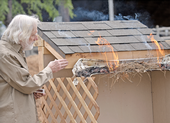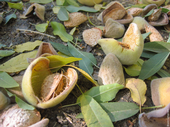- Author: Pamela S Kan-Rice

Priorities include removing objects within five feet of a house, upgrading vents
Wildfire losses cost taxpayers and communities hundreds of billions of dollars each year, and preparing communities before a disaster occurs is the best way to avoid damage to homes and neighborhoods. Retrofitting existing homes can make communities safer while avoiding billions in disaster costs.
As Californians learn to live with wildfire, scientists encourage improving the structure and design of houses and other buildings to help...
- Author: Lauren Biron, Lawrence Berkeley National Laboratory
- Author: Pamela S Kan-Rice

UC ANR to help create database, support technology for sustainable bioproducts and biofuels
In California's Northern San Joaquin Valley, crop leftovers such as almond shells, fruit peels and orchard trimmings can potentially be converted into sustainable bioproducts and biofuels – with the right technology. The philanthropy Schmidt Sciences' Virtual Institute on Feedstocks of the Future, which supports replacing fossil feedstocks with renewable biomass sources, has awarded new funding to a...
- Author: Ria DeBiase, UC Giannini Foundation

How policies affect emissions, land use, and the prices of fuel and vegetable oils
Over the last two decades, both the federal government and state governments have enacted policies to reduce greenhouse gas (GHG) emissions in the transportation sector. In a new Special Issue of ARE Update, University of California agricultural economists explore how these federal and state renewable fuel policies have affected biofuel production for motor and aviation fuels and consider how these policies have affected land use and food prices. Their research shows that as U.S. demand for...
- Author: Nina Erlich-Williams, Public Good PR for LA Waterkeeper

Wastewater recycling in Los Angeles is the focus of a new report released by the UCLA Luskin Center for Innovation and the UC Agriculture and Natural Resources. The report, Making the Most of Landmark Recycled Water Investments in Los Angeles: Technical Advisory Recommendations for the Region, was commissioned by Los Angeles Waterkeeper. The goal of the report is to support ongoing efforts to improve local water security and rely less on expensive, energy-intensive and increasingly unreliable water imports from faraway places, like the...
- Author: Pamela S Kan-Rice

Additional guidance needed for groundwater management strategies
Cover crops are planted to protect and improve the soil between annual crops such as tomatoes or between rows of tree and vine crops, but growers may be concerned about the water use of these plants that don't generate income.
“Cover crops are one of the most popular practices we see farmers employ through our Healthy Soils Program,” said Karen Ross, secretary of the California Department of Food and Agriculture. “Cover crops supply a host of benefits, such as helping to protect against soil erosion, improving soil...



